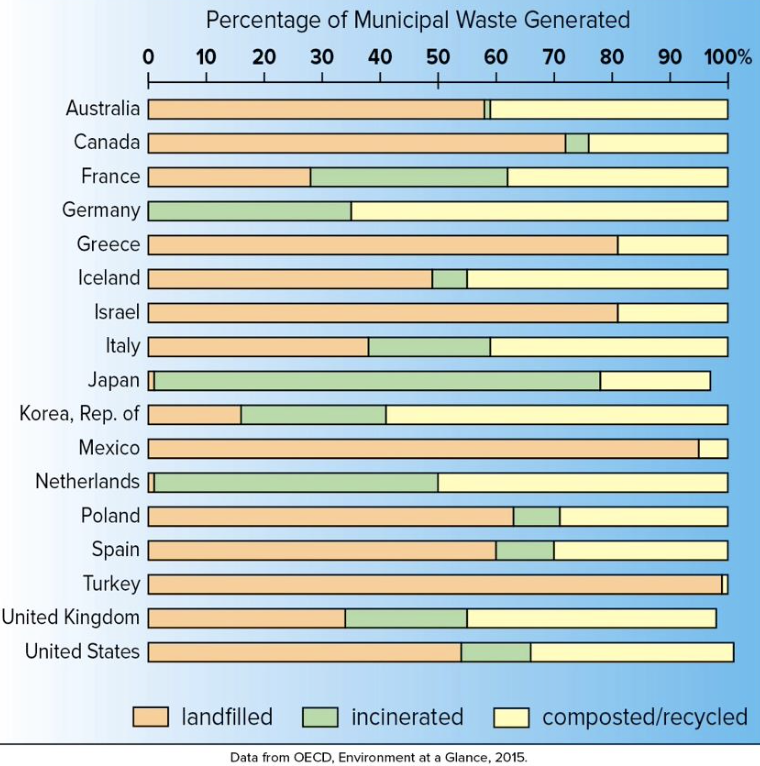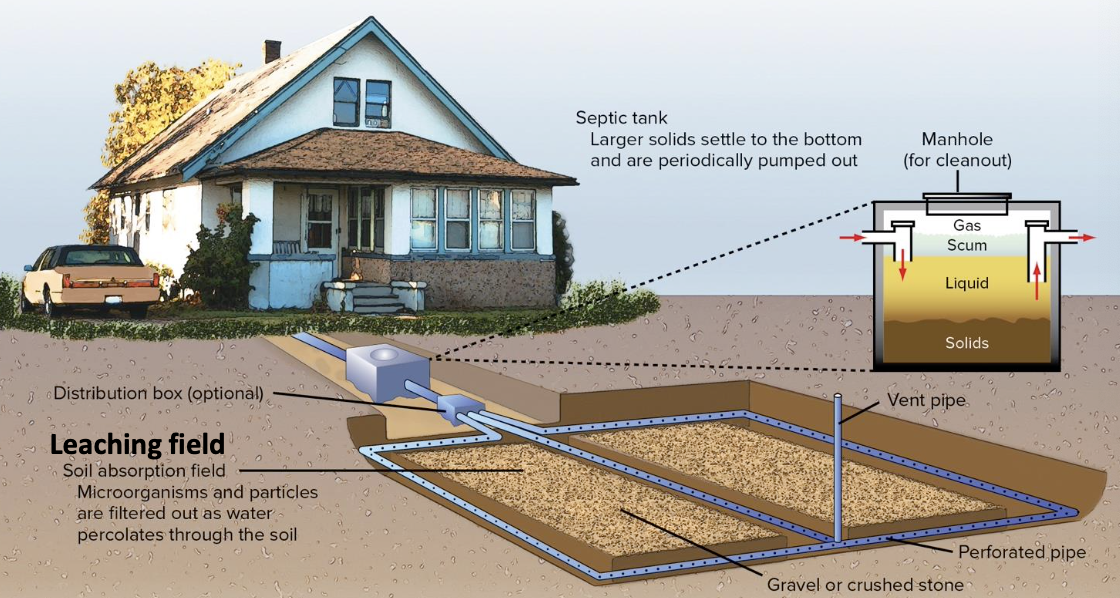Waste
Lecture 16 SCI250
Trash Stats
- Average American (Canadians are probably similar) generates 4lbs (2kg) of trash per day
- Packaging is ~65% of household trash
- Average college student produces 640 lbs of solid waste per year, including ~500 disposable cups and 320 lbs of paper
- North America has 8% of the world’s population but produces half of the world’s nonorganic trash
- Most communities are spending more on waste management than schoolbooks, fire, libraries and parks
- In USA: Household, industrial, agricultural, mineral waste
- 4 billion tons of solid waste (~800,000,000 Elephanst)
- 40 billion gallons of sewage wastewater per year (~80,000 Olympic pools)
Type of Waste
Waste
Any unwanted material or substance that results from human activity or process.
- Municipal solid waste = non-liquid waste that comes from homes, institutions, and small businesses
- Industrial solid waste = waste from production of consumer goods, mining, agriculture, and petroleum extraction and refining
- Hazardous waste = solid or liquid waste that is toxic, chemically reactive, flammable, radioactive, or corrosive
- Wastewater = water used in a household, business, or industry, as well as polluted runoff from our streets and storm drains
Overview:
- Solid waste
- Municipal waste disposal
- Reducing solid waste volume
- Toxic-waste disposal
- Sewage treatment
- Radioactive waste
Major sources of solid waste in USA & Canada
- Agriculture: crops and animals; more than 50% of solid waste
- Mineral industry: spoils, tailings, slag, other rock/mineral waste; major source
- Other industry: highly toxic; minor compared to others
- Municipalities: very visible; minor compared to others

Solid Wate - Agricultural
Over half our waste is from agriculture:
- Animal production - manure, bedding
- Food and meat processing - bits we don’t eat
- Crop production - harvest waste
- Horticultural production - landscaping
- Industrial agricultural (e.g., wood processing)
- Chemical wastes - herbicides, pesticides
Solid Waste - Mining
In Canada, mining waste >30 times that from household + municipal + industry
- 1 ton of iron 3 tons of waste
- 1 ton of copper, nickel, zinc, lithium or graphite 20 to 200 tons of waste
- 1 ton of platinum group elements, rare earth elements, or gold more than a million tons of waste
But waste can be valuable: Conservative estimate of ~$10 billion in total metal value remains in Canada gold mine waste.
Solid Waste - Industrial
Industrial waste NOT from mining:
- Together all of this is only a few percent of the total mining and agriculture waste
- Chemicals > paper > food

Municipal Waste
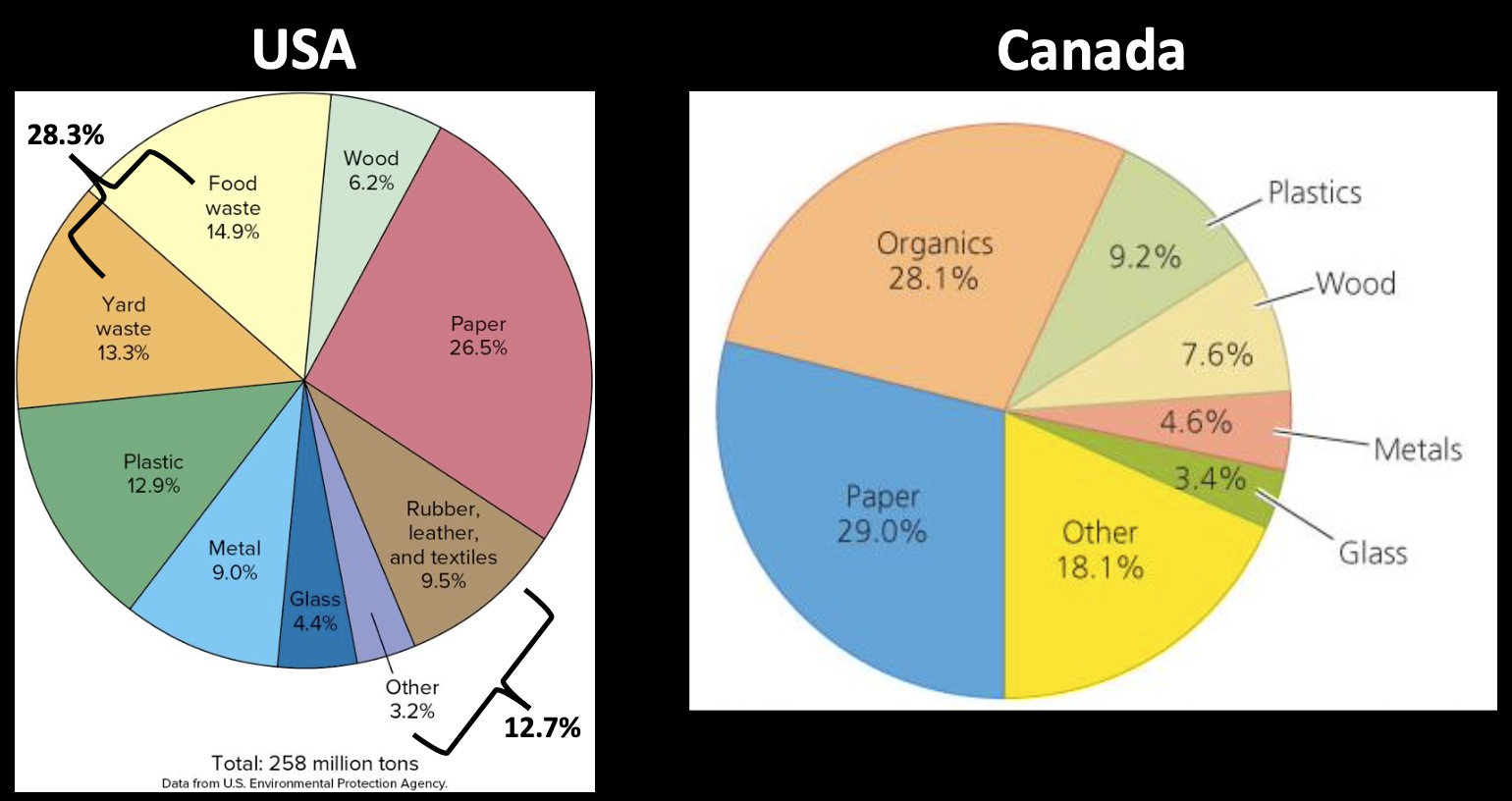
How to dispose of municipal waste?
Three options:
- Landfills
- Incinerate
- Compost/Recycle
Municipal Waste Disposal
Open dumps: easy and cheap method
- But are gross, smelly, attract animals, are fire hazards, leach chemicals, and erode
- Illegal in USA since 1976 but hundreds of thousands still operating
- Main source of disposal in much of developing world
Sanitary Landfills: compacted trash is laid down and covered by layer of soil each day
- Most municipal waste disposed of this way
- Use valleys or abandoned pits or surface mines
- When full, covered by thick layer and repurposed
- Parks, pasture, parking lots, ski hills, golf courses, solar
- Nothing that needs to be excavated to build
Waterloo Landfill (across from Costco)
- Opened in 1972 and is only operating landfill in Waterloo Region
- 126 hectares and includes recycling facility
- Expected to reach capacity in 15-20 years
Landfill Gas
- Oxic: and ; Anoxic: and
- Usually vented or burned off
- captured for natural gas
More than 40 operational projects in Canada collect landfill gas and convert it into energy.
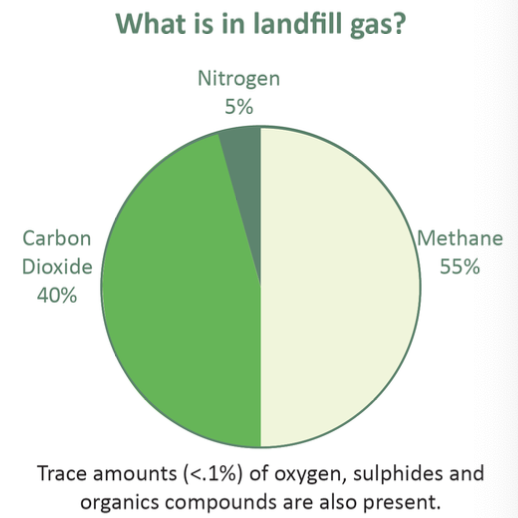

Leachate
Water containing dissolved chemicals from landfill can contaminate ground/surface water
- Problems in old landfills without impermeable layering at bottom
- Or problem if water table reaches base of landfill
- Now we build over bedrock or low permeable layers or line with impermeable material or clay
- To avoid spillover to surroundings (‘bathtub affect’) must not allow accumulation of leachate in landfill
- Build with low permeable layers below and above landfill
- Can pump out leachate or use plants to take up chemical-laden water (but not for crops)
Proper sanitary landfilling is complex
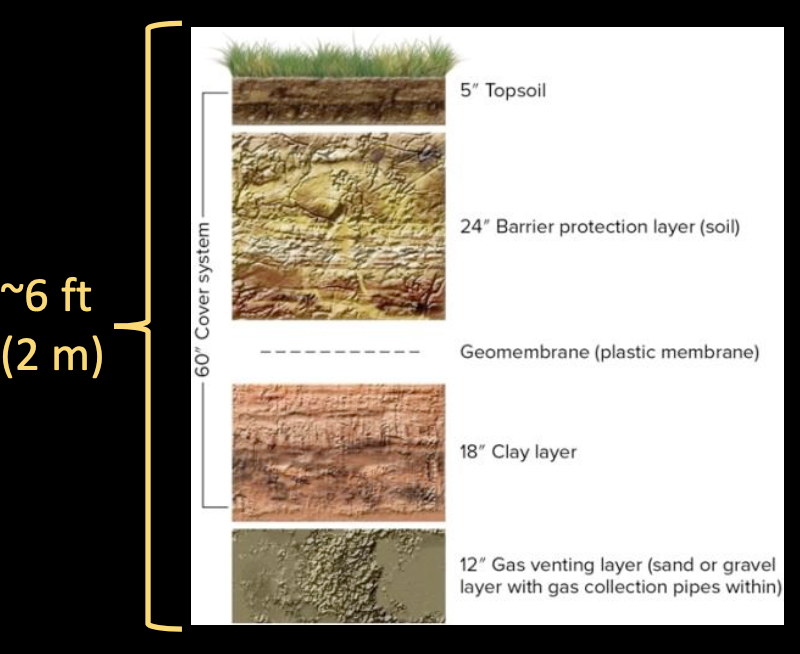

Landfills requires space
- Rule of thumb: One acre (half a soccer pitch) filled 3m deep per year for 10,000 people
- Toronto: 6,255,000 people 625 acres or > 300 soccer pitches
- USA produces 250 million tons of trash PER YEAR
- About 50,000,000 elephants
- Most sites were opened in 70s & 80s
- Harder to find new sites
- NIMBY - not in my backyard
- NIMFYE - not in my front yard either
- NIMEY - not in my election yaer
- NOPE - no on planet earth
- People: landfill ration increasing
Incineration
- Solves space issue but releases pollutants
- Everything
- Plastics chlorine gas, hydrochloric acid, hydrogen cyande
- Organic matter
- Technology has improved
- Higher temperatures breakdown complex organics into just and
- But toxic elements like mercury or lead may still be released
- Only combustibles should be burned, like paper and wood, and can be used as a source of heat
- Many countries adopted this practice and growing in popularity elsewhere
Ocean dumping
- Used to be popular (80% of NYC trash went into oceans and lined the shores)
- Still done to some degree either after incinerating or without burning, but has waned
- Hazardous chemicals often treated this way
- Banned sewage and industrial waste dumping in USA in 1991
- Dredge spoils (sediments dredged from reservoirs and waterways)
- Still allowed to dump 200 million tons/year
- Pollutants very possible
Reducing Solid-Waste Volume

- Try other ways to reduce waste first
- Disposal is last resort
- Compaction helps reduce volume, but…
- Lose anything recoverable
- Slows organic matter decomposition, which is already slow in dry landfills
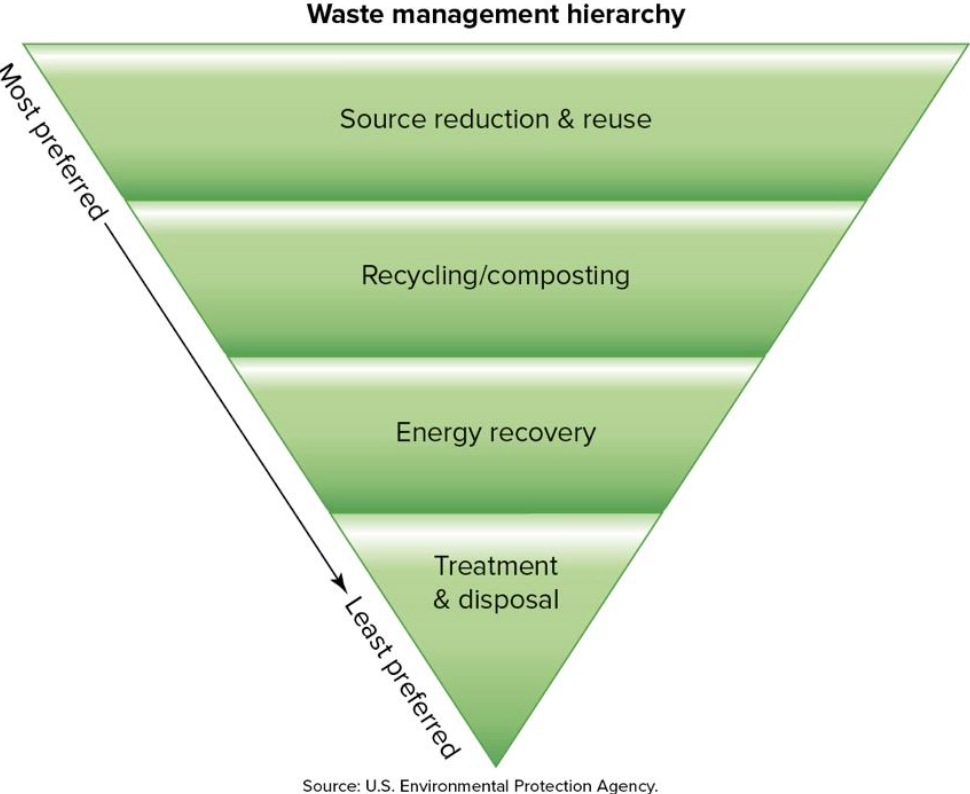
Organic Matter
- Composting household and yard waste produces fertile soil
- USA - 60% of yard waste is composted
- Household waste - by individuals mostly
- Some towns and countries compost on a municipal level

Recycling Glass
- Glass can spend a million years in a landfill
- All provinces, except Nunavut and Ontario only alcohol
Recycling Paper
- One of easiest to recycle but best when single type
- Saves landfill space, trees, water, and energy (i.e., gasoline)
Recycling Rates
- USA – 65% of all paper
- Canada – 25% of all paper
- Both countries recycle 85-90% of their cardboard

Recycling Plastic
- Plastics are durable and breakdown only at high temperatures
- Most plastics marked with symbol for easy separation
- Not often used for same product after recycling
- Repurposed into piping, stuffing for upholstery, carpet fiber, trash bags, plastic lumber
- More research into other uses – pillows, clothing, fiberglass

- Construction and demolition debris (concrete, asphalt, metal) can be repurposed in new construction
- Waste exchanges, e.g., Canadian Waste Materials Exchange, supports the exchange between states, provinces, companies
- E-waste/E-cycling – electronics have toxic elements (lead, cadmium, mercury)
- Mostly goes to South and East Asia

Toxic-Waste Disposal
- Toxic-waste is often liquid
- Concentrated, highly-toxic by-product of industry

Previous Methods
- Dilute-and-disperse: belief that toxins are less toxic when dilute
- E.g., ocean dumping
- Not the case with many chemicals and bioaccumulation in food chain likely
- Concentrate-and-contain: leads to disasters
- Buried in pits or trenches or metal/plastic boxes in landfills
- Example, Love Canal, New York: near Niagara Falls

Secure Landfills
- Hole lined with plastic and/or clay
- Toxic waste in drums
- Wells drilled for monitoring
- But they still do leak

Deep-Well Disposal
- Need porous and permeable rock (e.g., sandstone or fractured limestone) bordered by low-permeability layers (e.g., shale)
- 100s to 1000s m deep, below water table
- Assume lateral movement is so slow that chemical will be diluted by the time it reaches an aquifer
- Costs similar to secure landfill but sites are more limited
- Earthquakes can happen
Other types
- Furnaces to burn it
- Chemical treatments
- Waste exchange
Sewage Treatment
Need to treat our wastewater before it mixes with surface or groundwater
- Why? Prevent oxygen depletion, algal blooms, and spread of pathogens
Septic Systems
Solids settle in tank
Liquid seep into leaching field (soil adsorption field) where organic matter and some pathogens broken down by microbes
Chemical and particulates filtered out and broken down
Geologic requirements for a septic system
- Soil must have certain permeability
- Water table must be well below
- ~60 cm of topsoil and 150 cm below
- Not within 15 m of surface water
Size requirement for a septic system
- Size determined by soil permeability and number of people using it
- Determined by city
- Not suitable for high population densities
Municipal Sewage Treatment:

- Primary is physical treatment
- Secondary is biological treatment
- These stages reduce solids and DOM by 90%, N by 50%, P by 33%
- Tertiary is costly and uncommon (few % in USA)
Waterloo Region has 13 wastewater treatment plants that process 155 million liters of water per day (~3600 swimming pools)
Treated sewage water can be used
- Drinking water
- Irrigation
- Recharge marshes or ponds
- Fish hatchery
- Recharge geothermal reservoir
Sludge needs to be dealt with
- Fertilizer for parks, athletic fields, golf course, but not crops
- Landfilled
- Burned
Global average: 52% of sewage treated but heavily varies. In some countries, 90% ends up in surface water.
Radioactive Waste
- Radioactive isotopes with half-lives of years to 100s years are most dangerous
- Long or short half-lives are usually not (e.g., U-238 @ 4.5 billion years)
- Unless toxic, like Plutonium-239 (24,000 years), or they are concentrated naturally in our own systems:
- Iodine-131, 8 days, in thyroid gland
- Iron-59, 45 days, hemoglobin in blood
- Cesium-137, 30 years, nervous system
- Strontium-90, 29 years, bones, teeth, milk

- 86-90% of radioactive waste is low level and taken care of on-site or at a containment facility
- Released to environment or landfills when radiation levels are low
- E.g., gases, liquids from laundry or cleaning, solids from fibers
- Remaining 10% is high level radioactive waste and is the hazard
- Spent (used) fuel (also called fuel rods) and by-products of fabrication and reprocessing are the biggest sources of radioactivity
Nuclear ‘fuel’ is made of ceramic pellets of enriched uranium that are packed into metal rods
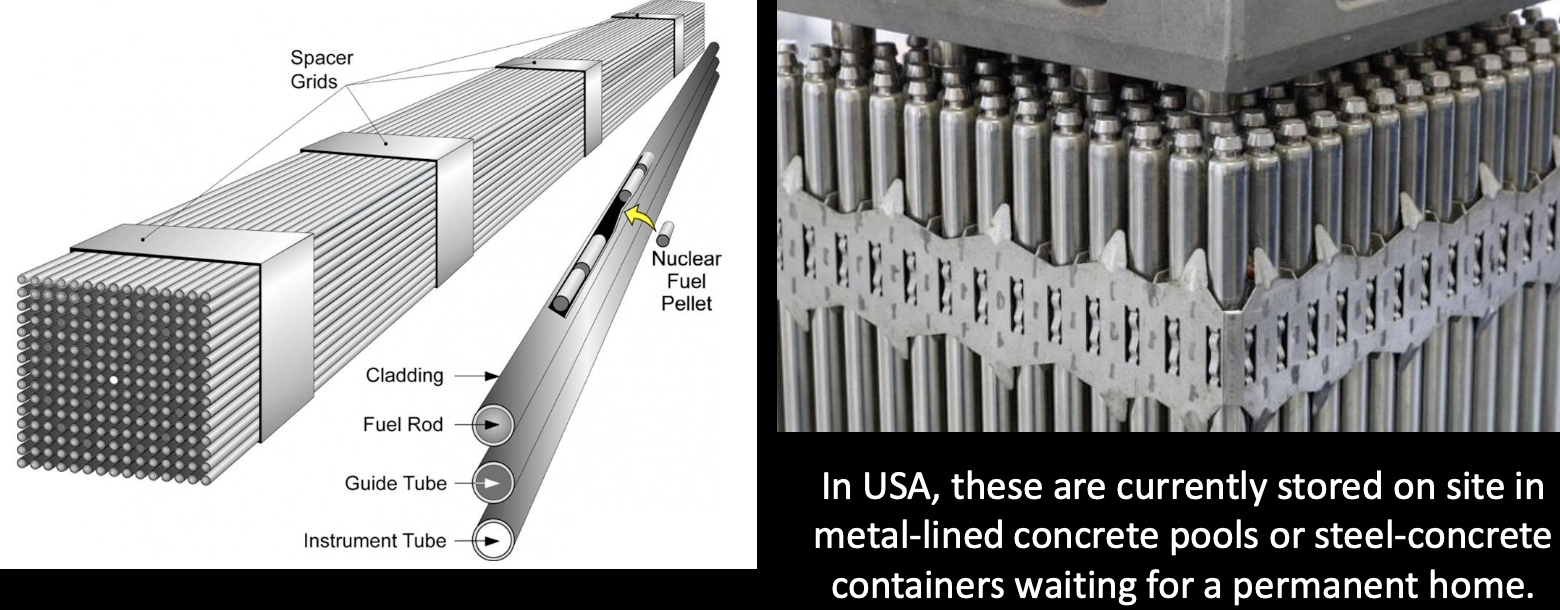
USA has a total of 83,000 metric tons of spent fuel in 76 sites in 34 states
- Can fit in one football field (90x50m) to a depth of 30ft (10m)
- USA would have the most spent fuel that needs to be stored based on country-specific production

Historical suggestions:
- Rocket into space with a (hopefully) successful launch
- Melt its way into Antarctic ice and be covered again by ice
- Carried to mantle via subduction in a seafloor trench
- Sinking them into stable clays of the deep-sea floor*
- *Was being looked into the most in the 1980s but nothing since
Liquid High-Level Waste
- Currently stored in cooled underground tanks that leak
- Hanford facility in Washington state
- 50 million gallons, of which 1 million has leaked into Columbia River and costs $2 billion per year to remediate
- Caverns in low-permeability, unfractured igneous rocks better option
- But cannot guarantee the geologic stability of the rock and liquids migrate
- Solidifying the liquids then storing this way is what is being considered
Solid High-Level Waste
- Multiple barrier concept in a secure bedrock formation
- Granite: strong, table, low porosity, insoluble minerals but can fracture
- USA, Sweden, Finland, Switzerland and Japan testing granite
- Thick basalts: strong when fresh and unfractured, can withstand and disperse heat, but can contain porous zones and weathers easily
- Massive deposits of tuff – from past pyroclastic volcanic eruptions
- Shale or other clay-rich sedimentary rocks – adsorb well, low permeability, but fracture readily and decompose at elevated temperature
- Salt – high melting point, low porosity and permeability, flows plastically, but would need to be in a dry environment
- Granite: strong, table, low porosity, insoluble minerals but can fracture


